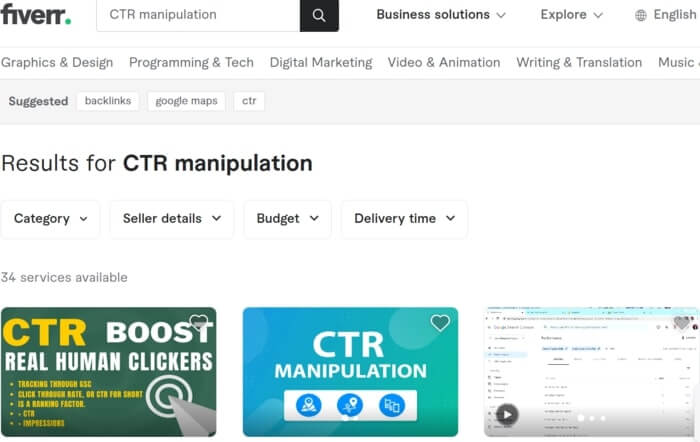Maximizing Organic Click-Through Fees With CTR Adjustment
The optimization of organic click-through prices (CTR) is a nuanced venture that hinges on understanding both customer psychology and effective material discussion. By leveraging strategic adjustment strategies, such as strongly crafted headlines and aesthetically appealing aspects, online marketers can substantially improve individual involvement. Nevertheless, the landscape is raging with misunderstandings and oversimplifications regarding what absolutely drives CTR. As we discover the complexities of these methods, it ends up being vital to discern the underlying principles that can cause sustained success in capturing target market attention. What genuinely sets apart the reliable from the inefficient in this important aspect of digital advertising?
Recognizing Click-Through Fees
Comprehending click-through prices (CTR) is necessary for evaluating the effectiveness of internet marketing techniques. CTR gauges the portion of individuals who click a specific link or promotion compared to the total variety of individuals who watch it. A higher CTR indicates that the content is engaging and appropriate to the target audience, while a lower CTR might signify a demand for optimization.
To compute CTR, divide the variety of clicks by the number of impacts and multiply by 100. If an ad gets 300 clicks out of 10,000 impressions, the CTR would be 3%. This statistics is vital for assessing various elements of electronic marketing, including search engine optimization (SEARCH ENGINE OPTIMIZATION), e-mail projects, and social media advertising and marketing.
Furthermore, evaluating CTR helps marketing professionals recognize which techniques produce the most effective results and which need refinement. By concentrating on improving CTR, businesses can improve their material's exposure and effectiveness, leading to increased website traffic and prospective conversions. Recognizing the nuances of CTR is foundational for any type of online marketer aiming to optimize their on the internet presence and take full advantage of roi (ROI)

The Psychology of Customer Actions
Customer behavior is substantially affected by mental aspects that determine just how people communicate with on the internet content. Understanding these aspects is crucial for enhancing click-through prices (CTR) in organic search outcomes. Cognitive predispositions, such as the anchoring effect, play a critical role in shaping customers' assumptions. Their first impacts can heavily affect their succeeding judgments regarding significance and integrity. when customers encounter details.
Emotional responses likewise dramatically effect user actions. Web content that resonates emotionally can trigger a feeling of urgency or inquisitiveness, motivating individuals to click. In addition, social proof-- such as user reviews or scores-- can enhance trust fund and urge engagement, as people frequently seek to the habits of others to notify their very own decisions.
Additionally, the principle of shortage can drive clicks - CTR Manipulation. Limited-time deals or unique content create a fear of losing out (FOMO), engaging users to act swiftly. Recognizing these psychological motorists allows online marketers to create more compelling web content that reverberates with their target market
Effective CTR Adjustment Methods
Leveraging emotional understandings can considerably boost click-through prices (CTR) through targeted adjustment methods. Among the most reliable methods is making use of engaging headlines that stimulate inquisitiveness or necessity. Phrasing titles as concerns or including numbers can bring in even more attention, triggering customers to click.
Another strategy includes maximizing meta descriptions to produce a sense of relevance and immediacy. By clearly outlining the benefits or services provided in the content, you can involve potential readers and encourage them to click. Additionally, utilizing power words-- such as "special," "shown," or "free"-- can improve the allure of your web content.
Visual elements likewise play a vital duty. Integrating attractive images or thumbnails can draw users in and enhance CTR. A/B testing various visuals can help identify which photos reverberate finest with your audience.
Finally, guaranteeing that your web content guarantees deliverable worth leads to higher CTR. When users perceive that clicking will certainly offer them with meaningful understandings or solutions, they are most likely to involve. By using these methods attentively, marketers can efficiently manipulate CTR to their advantage while maintaining honest standards.
Common Myths Regarding CTR
Numerous false impressions surround click-through prices this content (CTR) that can lead online marketers to make illinformed choices. One common myth is that a greater CTR constantly translates to better efficiency. While a high CTR suggests that even more customers are clicking, it does not ensure sales or conversions. Ultimately, the effectiveness of traffic depends upon the top quality of the touchdown web page and the importance of the web content.
One more common belief is that CTR is a separated metric. In fact, CTR ought to be examined along with other efficiency indications, such as bounce price and conversion price, to obtain an alternative sight of project success.
In addition, some marketing experts assume that maximizing for CTR alone suffices. Focusing solely on CTR can lead to clickbait methods that may draw in clicks yet fall short to engage customers meaningfully. CTR Manipulation. This technique can damage brand reputation and result in reduced retention rates
Last but not least, there is a concept that CTR techniques are widely efficient. The truth is that optimal CTR strategies can differ considerably across sectors and target market, requiring tailored methods for different market sectors. Comprehending these misconceptions is critical for creating reliable CTR strategies that straighten with overarching advertising and marketing goals.
Determining CTR Success
Although high click-through rates (CTR) can show effective interaction with content, measuring their true success needs a detailed evaluation of numerous aspects. Initially, it is necessary to understand the context in which the CTR is accomplished. A high CTR on a deceptive title may not equate to purposeful involvement or conversions, eventually mirroring badly on the brand's credibility.
Second, evaluating the resource of web traffic is critical. Organic web traffic from online search engine can represent a robust material technique, while clicks from unnecessary resources might suggest a lack of targeting. Furthermore, gauging the succeeding customer habits is vital; assessing metrics such as bounce price, time spent on web page, and conversion prices can offer deeper understandings right into the top quality of the involvement launched by the CTR.

Conclusion

The optimization of organic click-through rates (CTR) is a nuanced venture that pivots on recognizing both customer psychology and reliable material discussion. CTR determines the percentage of customers who click on a particular link or ad compared to the overall number of customers that view it. A higher CTR suggests that the web content is engaging and relevant to the target audience, while a reduced CTR may signify a requirement for optimization.
Focusing solely on CTR can lead to clickbait techniques that may attract clicks yet stop working to engage individuals meaningfully. Additionally, gauging the subsequent customer behavior is vital; analyzing metrics such as bounce price, time spent on page, and conversion prices can supply much deeper insights into the high quality of the interaction started by the CTR.